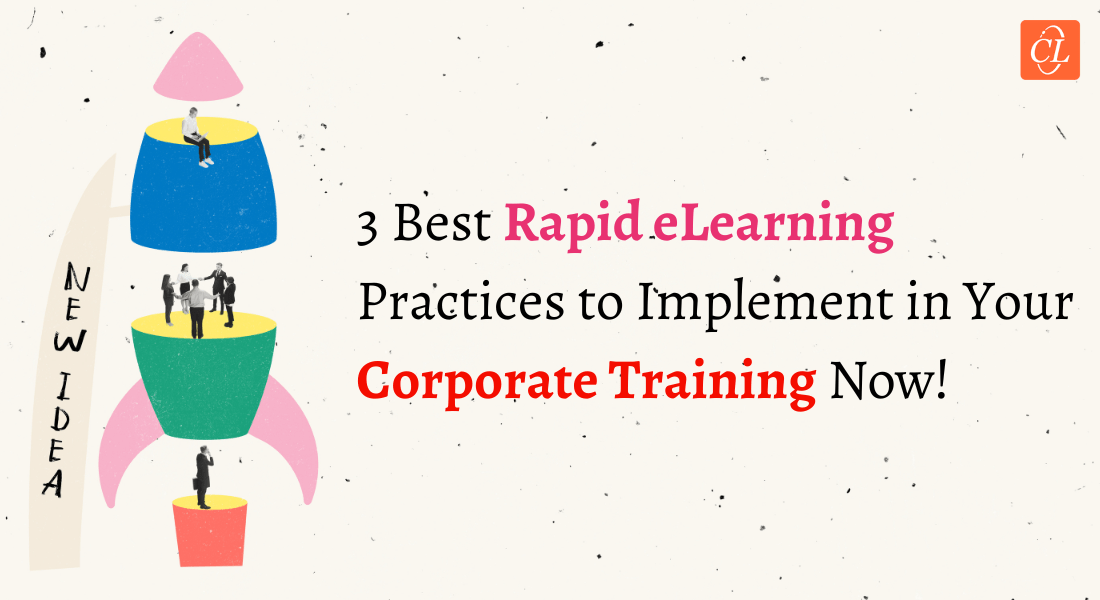The What, How, and Why of Rapid eLearning
Do you feel that rapid eLearning makes eLearning courses boring and makes the learners lose interest in the courses? Here’s a blog that will take you through some ways to make your rapid eLearning dynamic.

Let’s admit it, we’ve all been there, most of us believed that rapid eLearning courses are not interesting and lose learners’ interest as a result. In my opinion, this is only a fallacy. Because rapid eLearning courses are very engaging as there are many components that can be integrated into the to make them interesting and enjoyable for the learners. Continue reading to know about the different components that are used to create engaging rapid eLearning courses.
Rapid eLearning is a Method for Creating High-Quality eLearning Courses Quickly and Affordably.
Look at a few prerequisites that must be met for rapid eLearning to be truly rapid.
- eLearning assessment question types and templates
- Responsive design for courses that work on mobile devices
- Pre-installed interactive templates that are reusable
- Tools that make it easy to create courses in multiple languages
- Up-to-date specifications for LMS compatibility
What are Rapid eLearning Courses?
Rapid eLearning is typically used for short-lived courses or updates that need to be released quickly. In addition, rapid eLearning content is either taken from legacy Flash courses or from current instructor-led courses (ILT). You can simplify the translation process by using a rapid authoring tool if you need to translate your courses into several languages. Rapid eLearning follows two guiding principles, regardless of your training needs: sound instructional design and skilled authoring.
Top 3 Compelling Reasons for Rapid eLearning Development
Rapid eLearning helps:
- With pre-existing content, quickly create eLearning courses. creates interesting eLearning courses using classroom material. creates microlearning modules out of pre-existing content, such as videos, infographics, surveys, etc.
- HTML5 conversion of flash-based courses. Mobile devices are incompatible with Flash. Converting flash courses to HTML5 that work on multiple devices is simple.
- Updates courses as quickly as necessary. To quickly update and revise current courses, rapid eLearning uses rapid authoring tools like storyline 360, adobe captivate, dominKnow, etc. It’s not necessary to completely redesign the courses to make updates.
Now that you know about the benefits of using rapid eLearning development, it is time to learn about the various interactives that can be used to create interesting rapid eLearning courses.
A Handy Guide for Training Managers on Rapid eLearning Development
What Makes Authoring Tools the Key to Rapid eLearning Development?
Rapid eLearning is a method for creating high-quality eLearning courses quickly and affordably. But what prerequisites must be met for rapid eLearning to be truly rapid? Rapid authoring tools’ incredible feature is the solution.
- eLearning assessment question types and templates
- Responsive design for courses that work on mobile devices
- Pre-installed interactive templates that are reusable
- Tools that make it easy to create courses in multiple languages
- Up-to-date specifications for LMS compatibility
Top 3 Interactivities for Rapid eLearning Courses
1. Use Short Video
You should have an idea of how effective they are since more than 2 billion people watch videos on YouTube every day. According to research, videos are a useful tool for achieving learning goals in e-learning quickly. Additionally, they draw learners’ attention and improve the eLearning course’s aesthetic appeal. Videos are more engaging than graphics or animations. They are a great way to demonstrate the characteristics of the product. In terms of viewership, a one- to two-minute-long, concise, and direct video will work best.
2. Include Games
Gamification technologies for quick eLearning may make a course enjoyable and participatory, as opposed to one that only requires page-turning. Playing games promotes active learning and doing. They don’t make us memorize facts or information. In-game feedback on our decisions is another feature. Games include elements like challenge, engagement, motivating feedback, and reward that make eLearning interesting, inspire learners and enhance user experiences. Rapid-writing tools are constantly being enhanced with the ability to create games. Gamification in rapid eLearning makes the courses fun and encourages learners to take part.
3. Use Interactive Elements
For those creating highly interactive courses, rapid writing tools present a significant challenge. Interactivity includes things like audio, animation, slide shows, videos, clickable tabs, images, and graphics. An eLearning course needs to be purposefully interactive to maintain the learner’s interest. Since eLearning is self-paced, it requires effort to maintain the learner’s interest in the subject matter.
Activities have the potential to keep learners’ attention for a long time. These exercises are designed to appeal to a range of learners with different learning styles, including kinaesthetic, visual, and auditory learners.
End Note
Rapid eLearning makes it simple to develop learner-centered courses based on instructional design principles, including using learning objectives to demonstrate to learners what they stand to gain from the course, leaving the navigation open to allow for self-directed learning, and incorporating cutting-edge learning strategies.
Explore more in this eBook.





